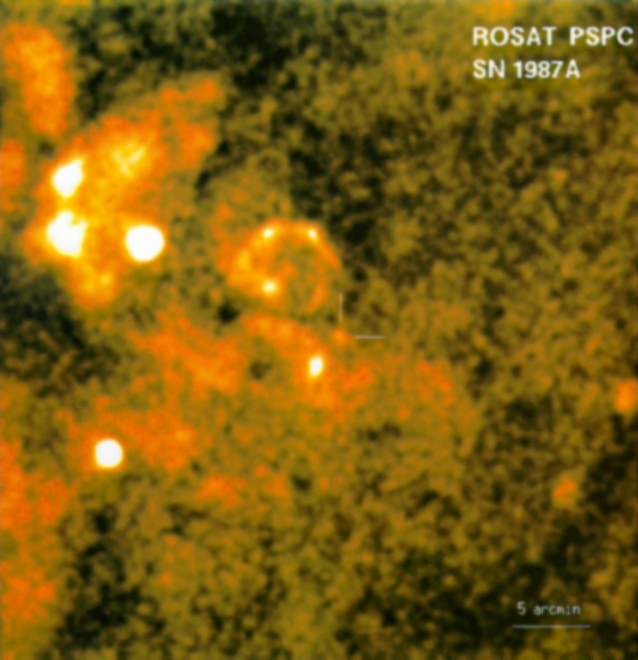
 Credit: Max-Planck-Institut für extraterrestrische Physik and theROSAT Mission
Credit: Max-Planck-Institut für extraterrestrische Physik and theROSAT Mission
First X-rays from SN 1987A
Supernovae explosions are extraordinary occurences. In these explosions a
star blows itself apart by (paradoxically) collapsing in on itself. The
collapsed part of the star forms a neutron star or black hole, while the
exploded part forms a cloud of hot gas and dust enriched in heavy elements
like carbon, oxygen, nitrogen, silicon, iron, and others, all important for
the formation of rocky planets and life. Typically a few dozen supernovae
may be detected each year, but since they mostly occur in distant galaxies,
they are difficult to study in detail. X-ray emission from nearby
supernovae is of great interest to astronomers, since it allows astronomers
to see exactly how the explosion develops, and in principle give the
astronomers the ability to view the evolution of a neutron star or black
hole from infancy. On February 23, 1987, a massive blue star in the Large
Magellanic Cloud exploded. Astronomers eagerly awaited the first detection
of the X-ray emission from this explosion, an event known as SN 1987A, but
it was not until mid 1991 that X-rays from the supernova were detected. The
image above shows the first positive
detection of the supernova, obtained by the ROSAT
Position Sensitive Proportional Counter imager. The position of the SN
1987A is marked by the two tickmarks. The supernova appears very faint in
this first image, but recently the supernova has brightened in X-rays, and
new observations with the Chandra
observatory have shown an X-ray bright
ring produced by the explosion.
Last Week *
HEA Dictionary * Archive
* Search HEAPOW
* Education
Each week the HEASARC
brings you new, exciting and beautiful images from X-ray and Gamma ray
astronomy. Check back each week and be sure to check out the HEAPOW archive!
Page Author: Dr. Michael F.
Corcoran
Last modified August 5, 2001


